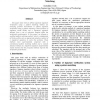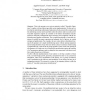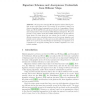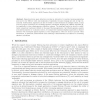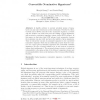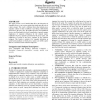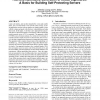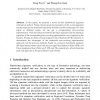93
Voted
ICDAR
2003
IEEE
15 years 6 months ago
2003
IEEE
This paper deals with an off-line Japanese signature verification using a pattern matching method. An annoying problem encountered in off-line signature verification using a patte...
93
Voted
EUROSEC
2010
ACM
15 years 6 months ago
2010
ACM
The prevalent use of the signature-based approach in modern intrusion detection systems (IDS) emphasizes the importance of the efficient management of the employed signature sets....
118
Voted
EUROCRYPT
2004
Springer
15 years 6 months ago
2004
Springer
Abstract. This work presents a new privacy primitive called “Traceable Signatures”, together with an efficient provably secure implementation. To this end, we develop the unde...
CRYPTO
2004
Springer
15 years 6 months ago
2004
Springer
Abstract. We propose a new and efficient signature scheme that is provably secure in the plain model. The security of our scheme is based on a discrete-logarithm-based assumption p...
CEAS
2004
Springer
15 years 6 months ago
2004
Springer
Signature-driven spam detection provides an alternative to machine learning approaches and can be very effective when near-duplicates of essentially the same message are sent in h...
117
Voted
CCS
2004
ACM
15 years 6 months ago
2004
ACM
This paper describes the direct anonymous attestation scheme (DAA). This scheme was adopted by the Trusted Computing Group as the method for remote authentication of a hardware mo...
ACISP
2004
Springer
15 years 6 months ago
2004
Springer
Abstract. A feasible solution to prevent potential misuse of signatures is to put some restrictions on their verification. Therefore S.J.Kim, S.J.Park and D.H.Won introduced the n...
108
Voted
SAC
2004
ACM
15 years 6 months ago
2004
ACM
This paper presents a novel method that allows the delegation of signature power to one or more entities that jointly play the role of a proxy signer. This work is different from ...
128
click to vote
CCS
2005
ACM
15 years 6 months ago
2005
ACM
Large-scale attacks, such as those launched by worms and zombie farms, pose a serious threat to our network-centric society. Existing approaches such as software patches are simpl...
74
Voted
ICIC
2005
Springer
15 years 6 months ago
2005
Springer
In this paper, we propose a novel on-line handwritten signature verification method. Firstly, the pen-position parameters of the on-line signature are decomposed into multiscale si...
